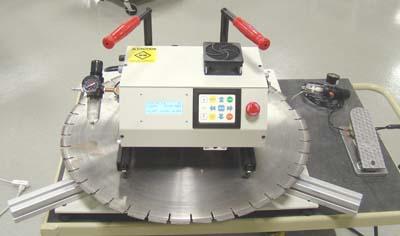
A new saw blade marking support is self contained, versatile and simple to operate. A benchtop base with three equally spaced (removable) arms is used to support saw blades with a range of diameters from 10" to 72". The three sliding spacers may be positioned along the length of the arms to suite the saw blade size. The steel plate is 24" square and includes four rubber feet to fit onto most benches. A 9.5"-dia. disc provides the solid support under the marking area. The operator slides the saw to the center then presses the foot pedal to extend the arbor. The Kwikmark (with the Porta-Stand) is slid towards the arbor. A tapered "pull" lock engages and centers the unit. The operator releases the foot pedal to retract the arbor, which clamps the Kwikmark and saw to the support disc. No other clamping is required.
By removing the aluminum plate you have a standard Porta Stand and Kwikmark that may be used for traditional part marking as well. The unique dot peen process "floats" on the material surface during the marking operation, making it ideal for flat, curved and irregular surfaces, as well as rough castings. Just press one key and enter the text to mark, on the included keyboard. No software to learn or manuals to read.
Contact Details
Related Glossary Terms
- arbor
arbor
Shaft used for rotary support in machining applications. In grinding, the spindle for mounting the wheel; in milling and other cutting operations, the shaft for mounting the cutter.
- centers
centers
Cone-shaped pins that support a workpiece by one or two ends during machining. The centers fit into holes drilled in the workpiece ends. Centers that turn with the workpiece are called “live” centers; those that do not are called “dead” centers.
- flat ( screw flat)
flat ( screw flat)
Flat surface machined into the shank of a cutting tool for enhanced holding of the tool.
- sawing machine ( saw)
sawing machine ( saw)
Machine designed to use a serrated-tooth blade to cut metal or other material. Comes in a wide variety of styles but takes one of four basic forms: hacksaw (a simple, rugged machine that uses a reciprocating motion to part metal or other material); cold or circular saw (powers a circular blade that cuts structural materials); bandsaw (runs an endless band; the two basic types are cutoff and contour band machines, which cut intricate contours and shapes); and abrasive cutoff saw (similar in appearance to the cold saw, but uses an abrasive disc that rotates at high speeds rather than a blade with serrated teeth).
